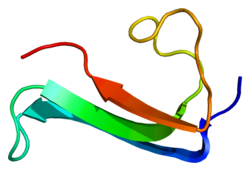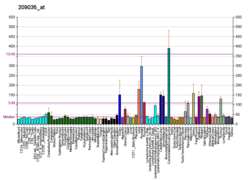
Midkine
Midkine (MK or MDK), also known as neurite growth-promoting factor 2 (NEGF2), is a protein that in humans is encoded by the MDK gene.
Midkine is a basic heparin-binding growth factor of low molecular weight, and forms a family with pleiotrophin (NEGF1, 46% homologous with MK). It is a nonglycosylated protein, composed of two domains held by disulfide bridges. It is a developmentally important retinoic acid-responsive gene product strongly induced during mid-gestation, hence the name midkine. Restricted mainly to certain tissues in the normal adult, it is strongly induced during oncogenesis, inflammation and tissue repair.
MK is pleiotropic, capable of exerting activities such as cell proliferation, cell migration, angiogenesis and fibrinolysis. A molecular complex containing receptor-type tyrosine phosphatase zeta (PTPζ), low density lipoprotein receptor-related protein (LRP1), anaplastic leukemia kinase (ALK) and syndecans is considered to be its receptor.
Role in cancer
MK appears to enhance the angiogenic and proliferative activities of cancer cells. The expression of MK (mRNA and protein expression) has been found to be elevated in multiple cancer types, such as neuroblastoma, glioblastoma, Wilms' tumors, thyroid papillary carcinomas, colorectal, liver, ovary, bladder, breast, lung, esophageal, stomach, and prostate cancers. Serum MK in normal individuals is usually less than 0.5-0.6 ng/ml, whereas patients with these malignancies have much higher levels than this. In some cases, these elevated levels of MK also indicate a poorer prognosis of the disease, such as in neuroblastoma, glioblastoma, and bladder carcinomas. In neuroblastoma, for example, the levels of MK are elevated about three times the level in Stage 4 of the cancer (one of the final stages) than they are in Stage 1.
In neuroblastoma, MK has been found to be over expressed in the cancer cells that are resistant to chemotherapeutic drugs. The resistance to chemotherapy seems to be reversible by administering chemo-resensitization drugs, such as verapamil, which acts not via MK alteration, but by inhibiting the P-glycoprotein pump that exports cytotoxins out of cells. Since chemotherapeutic drugs are cytotoxic, the drugs administered are also exported by this pump, rendering the chemotherapy ineffective. It has been found that when the neuroblastoma cells that are resistant to chemotherapy are grown in co-culture with the wild type (WT), or chemotherapy-sensitive cells, the resistance to chemotherapy is conferred to the wild type cells, and thus no cell death or senescence occurs in either cell type, despite the chemotherapeutic treatment. MK has been identified as one of the factors that "transfers" this chemoresistance from the resistant cells to the WT cells.
MK is a secreted protein, and is therefore found in the microenvironment (media) of the resistant neuroblastoma cells. Following co-culture experiments and the determination that MK was one of the factors that was conferring chemo-resistance to the wild, non-resistant cell type, the gene for MK was transfected into WT cells to determine if MK was overexpressed in the WT cells themselves, would the cells become resistant to chemotherapy independent of resistant cell influence. The tests further confirmed that MK specifically increased chemotherapeutic resistance in the transfected WT-MK cells versus regular WT cells, confirming the specific chemoresistant properties of MK.
In addition, the mechanism for such anti-apoptotic (anti-cell death) activity was studied, specifically using the chemotherapeutic Doxorubicin (Adriamycin) on osteosarcoma (Saos2) cells. Doxorubicin works by putting rampant cancer cells into a senescent state. MK, in WT-MK transfected cells versus WT cells, seemed to activate PKB (Akt), mTOR, and Bad protein, while it inactivated caspase-3. PKB, mTOR, and Bad are all elements associated with the cell cycle survival pathway, whereas caspase-3 is important in the apoptotic pathway (cell death). This indicates that MK caused the cells to initiate the survival pathway (via PKB, mTOR, and Bad activation) and inhibit the senescent or apoptotic pathway (via inhibiting caspase-3) encouraging the chemoresistance seen in resistant cells and in the co-culture experiments. The activation and inhibition of these particular factors clearly is maintaining the immortal quality inherent in cancer cells and specifically in the resistant cell types. Stat-3, however, which is another survival pathway factor, does not appear to have any change in activation between the wild type cells and the MK-transfected WT cells, as was initially believed from a previous study.
MK may potentially be indirectly targeted as a cancer treatment as a result of its cancerous proliferation properties. Drugs by the name of anti-cancer aptamers have been created to inhibit to proteins involved in MK's cancer cell "activation". Specifically, the extra-cellular matrix (ECM) protein nucleolin has been targeted with an aptamer that would bind nucleolin and prevent MK from being transported into cancerous cell nuclei, preventing the protein from enhancing the cancerous properties of the cell. Miyakawa et al. have successfully established the method to prepare the MDK specific RNA aptamers by the use of the recombinant midkine and pleiotrophin.
Mdk is also a tumor antigen able to induce CD8 and CD4 T cell responses (Kerzerho et al. 2010 Journal of Immunology).
HIV infection
Midkine binds to cell-surface nucleolin as a low affinity receptor. This binding can inhibit HIV infection.
Trivia
- In the Japanese film "L: Change the World", Midkine is used as a major plot element, as it is used in a vaccine to treat the ebola virus combined with influenza, from spreading.
Further reading
- Uehara K, Matsubara S, Kadomatsu K, et al. (1992). "Genomic structure of human midkine (MK), a retinoic acid-responsive growth/differentiation factor". J. Biochem. 111 (5): 563–7. doi:10.1093/oxfordjournals.jbchem.a123797. PMID 1639750.
- Wujek JR, Haleem-Smith H, Yamada Y, et al. (1991). "Evidence that the B2 chain of laminin is responsible for the neurite outgrowth-promoting activity of astrocyte extracellular matrix". Brain Res. Dev. Brain Res. 55 (2): 237–47. doi:10.1016/0165-3806(90)90205-D. PMID 1701366. S2CID 28040510.
- Kretschmer PJ, Fairhurst JL, Decker MM, et al. (1992). "Cloning, characterization and developmental regulation of two members of a novel human gene family of neurite outgrowth-promoting proteins". Growth Factors. 5 (2): 99–114. doi:10.3109/08977199109000275. PMID 1768439.
- Shoyab M, McDonald VL, Dick K, et al. (1991). "Amphiregulin-associated protein: complete amino acid sequence of a protein produced by the 12-0-tetradecanoylphorbol-13-acetate-treated human breast adenocarcinoma cell line MCF-7". Biochem. Biophys. Res. Commun. 179 (1): 572–8. doi:10.1016/0006-291X(91)91409-6. PMID 1883381.
- Tsutsui J, Uehara K, Kadomatsu K, et al. (1991). "A new family of heparin-binding factors: strong conservation of midkine (MK) sequences between the human and the mouse". Biochem. Biophys. Res. Commun. 176 (2): 792–7. doi:10.1016/S0006-291X(05)80255-4. PMID 2025291.
- O'Hara B, Jenkins NA, Gilbert DJ, et al. (1995). "Chromosomal assignment of the heparin-binding cytokine genes MDK and PTN in mouse and man". Cytogenet. Cell Genet. 69 (1–2): 40–3. doi:10.1159/000133934. PMID 7835084.
- Fairhurst JL, Kretschmer PJ, Kovacs E, et al. (1993). "Structure of the gene coding for the human retinoic acid-inducible factor, MK". DNA Cell Biol. 12 (2): 139–47. doi:10.1089/dna.1993.12.139. PMID 8471163.
- Kojima T, Katsumi A, Yamazaki T, et al. (1996). "Human ryudocan from endothelium-like cells binds basic fibroblast growth factor, midkine, and tissue factor pathway inhibitor". J. Biol. Chem. 271 (10): 5914–20. doi:10.1074/jbc.271.10.5914. PMID 8621465.
- Mahoney SA, Perry M, Seddon A, et al. (1996). "Transglutaminase forms midkine homodimers in cerebellar neurons and modulates the neurite-outgrowth response". Biochem. Biophys. Res. Commun. 224 (1): 147–52. doi:10.1006/bbrc.1996.0998. PMID 8694802.
- Nakanishi T, Kadomatsu K, Okamoto T, et al. (1997). "Expression of syndecan-1 and -3 during embryogenesis of the central nervous system in relation to binding with midkine". J. Biochem. 121 (2): 197–205. PMID 9089390.
- Iwasaki W, Nagata K, Hatanaka H, et al. (1998). "Solution structure of midkine, a new heparin-binding growth factor". EMBO J. 16 (23): 6936–46. doi:10.1093/emboj/16.23.6936. PMC 1170297. PMID 9384573.
- Ratovitski EA, Kotzbauer PT, Milbrandt J, et al. (1998). "Midkine induces tumor cell proliferation and binds to a high affinity signaling receptor associated with JAK tyrosine kinases". J. Biol. Chem. 273 (6): 3654–60. doi:10.1074/jbc.273.6.3654. PMID 9452495.
- Maeda N, Ichihara-Tanaka K, Kimura T, et al. (1999). "A receptor-like protein-tyrosine phosphatase PTPzeta/RPTPbeta binds a heparin-binding growth factor midkine. Involvement of arginine 78 of midkine in the high affinity binding to PTPzeta". J. Biol. Chem. 274 (18): 12474–9. doi:10.1074/jbc.274.18.12474. PMID 10212223.
- Meng K, Rodriguez-Peña A, Dimitrov T, et al. (2000). "Pleiotrophin signals increased tyrosine phosphorylation of β-catenin through inactivation of the intrinsic catalytic activity of the receptor-type protein tyrosine phosphatase β/ζ". Proc. Natl. Acad. Sci. U.S.A. 97 (6): 2603–8. Bibcode:2000PNAS...97.2603M. doi:10.1073/pnas.020487997. PMC 15975. PMID 10706604.
- Muramatsu H, Zou K, Sakaguchi N, et al. (2000). "LDL receptor-related protein as a component of the midkine receptor". Biochem. Biophys. Res. Commun. 270 (3): 936–41. doi:10.1006/bbrc.2000.2549. PMID 10772929.
- Kato M, Maeta H, Kato S, et al. (2001). "Immunohistochemical and in situ hybridization analyses of midkine expression in thyroid papillary carcinoma". Mod. Pathol. 13 (10): 1060–5. doi:10.1038/modpathol.3880195. PMID 11048798.
- Hayashi K, Kadomatsu K, Muramatsu T (2002). "Requirement of chondroitin sulfate/dermatan sulfate recognition in midkine-dependent migration of macrophages". Glycoconj. J. 18 (5): 401–6. doi:10.1023/A:1014864131288. PMID 11925507. S2CID 21224266.
- Sumi Y, Muramatsu H, Takei Y, et al. (2002). "Midkine, a heparin-binding growth factor, promotes growth and glycosaminoglycan synthesis of endothelial cells through its action on smooth muscle cells in an artificial blood vessel model". J. Cell Sci. 115 (Pt 13): 2659–67. doi:10.1242/jcs.115.13.2659. PMID 12077357.
- Stoica GE, Kuo A, Powers C, et al. (2002). "Midkine binds to anaplastic lymphoma kinase (ALK) and acts as a growth factor for different cell types". J. Biol. Chem. 277 (39): 35990–8. doi:10.1074/jbc.M205749200. PMID 12122009.
External links
- Overview of all the structural information available in the PDB for UniProt: P21741 (Midkine) at the PDBe-KB.
| Angiopoietin |
|
||||||||||
|---|---|---|---|---|---|---|---|---|---|---|---|
| CNTF |
|
||||||||||
| EGF (ErbB) |
|
||||||||||
| FGF |
|
||||||||||
| HGF (c-Met) |
|
||||||||||
| IGF |
|
||||||||||
| LNGF (p75NTR) |
|
||||||||||
| PDGF |
|
||||||||||
| RET (GFL) |
|
||||||||||
| SCF (c-Kit) |
|
||||||||||
| TGFβ |
|
||||||||||
| Trk |
|
||||||||||
| VEGF |
|
||||||||||
| Others |
|
||||||||||







